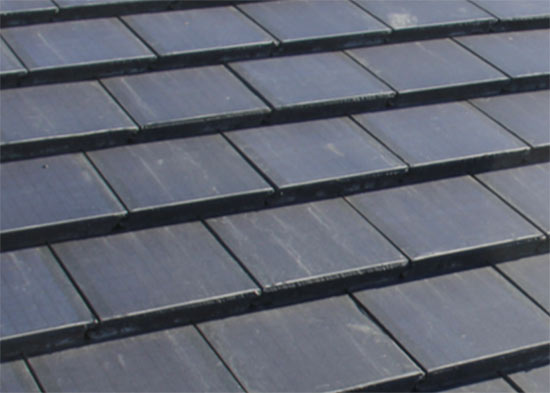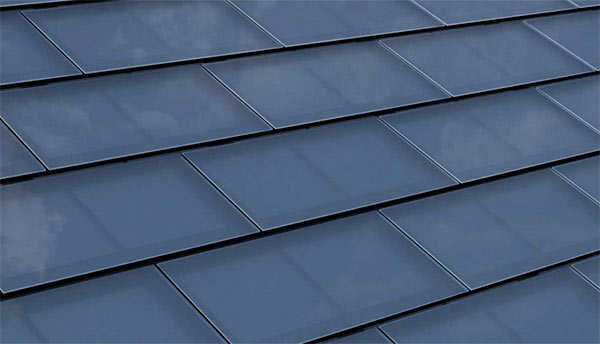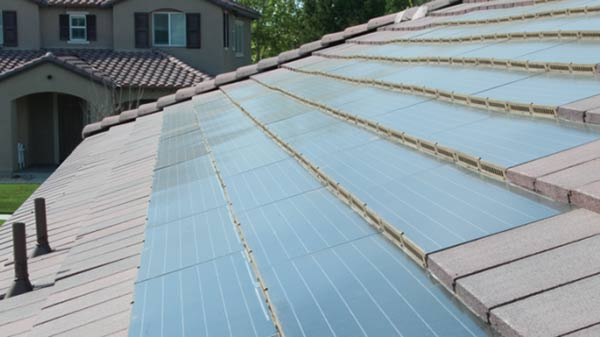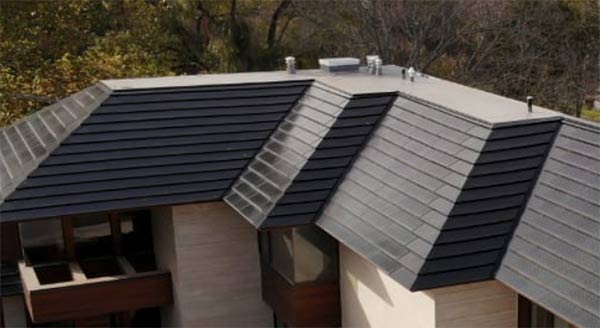When it comes to renewable energy sources, solar has always been one of the go-to choices and, in recent years, has seem much development and improvement and one such area has been their aesthetics.
With this in mind, in this guide we take a look at solar roof tiles, read on to find our more.
What are Solar Tiles?
Solar tiles, also known as solar roof tiles or solar shingles (mostly in the US), are an innovative technology that combines the functionality of traditional roofing tiles such as slate, concrete or clay tiles with the energy-generating capabilities of solar panels.
Unlike standard solar panels, which are mounted on top of your roof on a rail system and are considerably larger in comparison, solar tiles are seamlessly integrated into the roof itself with the aim of matching the existing style of tiles already on the roof, offering a sleek, modern alternative for homeowners looking to generate clean, renewable energy.
Where some properties, particularly period ones, may have very stringent and restrictive planning rules, such as those in conservation areas, adding traditional solar panels may not be an option. As solar tiles can be made to match common existing tiles, this often allows their installation without the need of considerable planning battles.

Standard slate-style solar tile
Types of Solar Tiles
In order to fit with the numerous different types, styles and layouts of roofs and slates, solar tiles are available in several different forms, the most common of these are as follows:
Photovoltaic (PV) Solar Tiles
Photovoltaic solar tiles are the most commonly used type. These tiles are embedded with photovoltaic cells that convert sunlight into electricity. The energy generated can power your home directly or be stored in batteries for later use. PV solar tiles are efficient, durable, and can seamlessly blend with several types of traditional roof tiles.
- Best For: Homeowners who want a reliable, energy-efficient solution that integrates smoothly with existing roof designs.
- Energy Output: These tiles are effective for homes that receive substantial sunlight exposure.
Thin-Film Solar Tiles
Thin-film solar tiles use a special technology that allows the photovoltaic material to be applied in very thin layers. This makes them lightweight and highly flexible, allowing for easier installation compared to bulkier solar tiles. Although their energy efficiency is typically lower than traditional PV solar tiles, they are ideal for homes with complex roof designs or specific aesthetic requirements.
- Best For: Homes with unusual roof shapes or those where weight is a concern.
- Energy Output: While less efficient than PV tiles, they perform well under various lighting conditions, including overcast skies.
Crystalline Solar Tiles
Crystalline solar tiles are typically made from either monocrystalline or polycrystalline silicon, similar to traditional solar panels. These tiles are highly efficient in converting sunlight into electricity, with monocrystalline tiles offering the highest energy output. However, they tend to be more expensive due to the advanced manufacturing process.
- Best For: Homeowners looking for maximum energy efficiency and long-term savings.
- Energy Output: High, especially for homes in sunny regions. Monocrystalline tiles typically offer superior performance compared to other types.
Solar Hybrid Tiles
Solar hybrid tiles combine the functionality of solar tiles with traditional roofing materials, offering both electricity generation and enhanced durability. They are designed to look like standard roof tiles, often made from materials like asphalt or slate, but with embedded solar cells. This design provides the dual benefit of protection from the elements while generating energy.
- Best For: Homeowners seeking the benefits of both traditional roofing and solar power in one product.
- Energy Output: Hybrid tiles may offer slightly lower energy efficiency than pure PV tiles but are excellent for homeowners prioritising style and functionality.
Custom-Built Solar Tiles
Some manufacturers offer custom-built solar tiles, tailored to match the unique design and architectural style of your home. These tiles can be made from a variety of materials and are engineered to blend seamlessly with the existing roof structure. Custom solar tiles are an excellent option for historical or high-end homes where aesthetics are paramount.
- Best For: Homes with specific design requirements or unique architectural features.
- Energy Output: Varies based on the type of solar cells used in the custom design.
By knowing about all of the different types of solar roof tile, you can then select the best tile for your home, ensuring it will meet all of your and your homes energy needs.
How do Solar Tiles Compare to Solar Panels?
On the whole, there are quite a few differences between solar tiles and traditional solar panels and it’s essential to know exactly what these are in order to make the most informed decision as to which you go for, here are some of the key differences:
- Roof Fitment/Installation: One of the big differences between the 2 is that, solar tiles physically replace your existing roof tiles, so can be a fairly large job and solar panels are installed on a rail system over your existing roof and tiles
- Designs: There are many different designs and styles of solar tile to match the many traditional styles of roof tile, whereas solar panels, due to their nature, are only available as large panels
- power Output: On the whole, solar panels are much more efficient than solar tiles. Tiles are generally between 10 and 20% efficient, while middle of the road panels are somewhere between 18 and 25% efficient, with some newer, more advanced panels being considerably more
- Cost: Solar tiles also tend to be much more expensive than solar panels, up to 50% more expensive in some cases
What are the Advantages and Disadvantages of Solar Roof Tiles?
To increase your knowledge base even further and help with any decisions you may need to make, it’s also essential to know what advantages and disadvantages solar tiles have. Here follows a list of the most common of each:
Advantages of Solar Roof Tiles
Aesthetic Appeal: One of the main advantages of solar roof tiles is the fact they match existing roof tiles. Unlike bulky solar panels, solar tiles resemble traditional roof materials, such as asphalt or slate, offering a much more visually pleasing finish, especially for period properties and those with planning restrictions.
Dual Functionality: Solar roof tiles serve two purposes: they act as both a roof covering and a solar energy generator. By replacing traditional roofing materials, you get both protection from the elements and a source of renewable energy.
Energy Savings and Efficiency: Just like solar panels, solar roof tiles harness energy from the sun to generate electricity, helping to reduce your home’s reliance on the grid. Over time, this can result in substantial savings on electricity bills, especially in regions with abundant sunlight.
Durability: Solar roof tiles are generally built to last. Made from durable materials like tempered glass, they are designed to withstand harsh weather conditions, including hail and high winds. This resilience makes them a long-term solution, with many manufacturers offering warranties of up to 25 years or more.
Disadvantages of Solar Roof Tiles
High Initial Cost: One of the main disadvantages of solar roof tiles is their significant upfront cost. They tend to be more expensive than both traditional roofing materials and conventional solar panels. While the long-term savings on energy bills can offset some of this initial expense, the high upfront cost can be a barrier for many homeowners.
Complex Installation: Installing solar roof tiles requires specialised expertise. The process is more complicated compared to standard roof installations or even the placement of traditional solar panels. Because of this, you’ll need to find a contractor who is experienced in working with solar roofing systems, which can be limiting and expensive.
Efficiency Compared to Solar Panels: While solar roof tiles are efficient at generating power, they are often less efficient than traditional solar panels. This means you may need more tiles to generate the same amount of energy, particularly if your roof has limited space or is not perfectly angled toward the sun. In such cases, you might not be able to fully meet your energy needs using solar tiles alone.
Limited Retrofitting Options: If you are not planning to replace your roof anytime soon, solar roof tiles may not be the best option. Retrofitting an existing roof with solar tiles is often impractical and very expensive. For homeowners looking to add solar power without replacing their roof, traditional solar panels are probably the way to go.
How Long do Solar Tiles Last?
Most solar roof tiles are designed to last 25 to 30 years or in some cases, even more. Most manufacturers typically offer warranties that guarantee their performance for this period, meaning the tiles should maintain a minimum threshold of power generation for their entire life.
Additionally as they are also a roof covering, they are guaranteed to last as long as any comparable roofing tile, again this is normally around 25 to 30 years, depending on product and manufacturer.
As with most building materials there are certain factors that can effect how long a solar tiles life span and effectiveness actually lasts for, these are:
- Quality of Materials: The materials used in solar roof tiles, such as tempered glass and high-grade photovoltaic (PV) cells, play an important role in how long the tile lasts. Tiles made from premium materials tend to last much longer and are more resistant to any weather damage.
- Installation and Maintenance: Proper installation is crucial to ensuring the longevity of solar roof tiles. If the tiles are not installed correctly, they may be more susceptible to damage from wind, rain, or hail. They also need to be maintained including cleaning and checking for damage.
- Weather Conditions: Solar roof tiles are built to withstand harsh weather conditions such as hail, snow, and high winds. However, extreme climates can still affect their performance and durability over time, if subjected to these extremes on a more regular basis.
- Degradation Rate: Like all solar products, solar tiles experience a natural degradation rate over time. This means their energy output will gradually decline, typically by around 0.5% to 1% per year. Even though the efficiency decreases slightly, solar tiles can still generate a considerable amount of electricity even after 25 years of use.
Who Makes Solar Roof Tiles?
If you are keen on getting some solar tiles installed on you home then another important factor to consider is the brand you go for, so here follows a run down of the most popular and well respected brands in the field.
Tesla
Tesla is one of the most well-known names in the solar roof tile and also panel industry, thanks to their Tesla Solar Roof. Introduced in 2016, Tesla’s solar tiles are designed to replace traditional roofing entirely, that results in a sleek and efficient system that looks like a regular roof.
They also come in different styles to mimic common roofing materials such as slate and asphalt.
Tesla’s tiles are built to last and come with a warranty of 25 years, ensuring they provide energy and roof protection for many years.

Tesla solar tiles
CertainTeed
They are a long-established roofing manufacturer that also produces solar tiles. Their Apollo II Solar Tiles are again designed to integrate seamlessly with traditional roofing systems, providing a less intrusive appearance compared to standard solar panels.
CertainTeed offers both solar tiles that can be laid alongside standard roof coverings and complete solar roofs, giving homeowners flexible options for incorporating solar energy into their homes.
They are renowned for their reliability and durability, and to confirm this, come with a 25-year warranty.

CertainTeed solar tiles
SunTegra
SunTegra is another leading manufacturer of solar roof tiles, offering both Solar Shingles and Solar Roof Tiles.
Both of these products are designed to blend in with existing roofing materials, making them an excellent choice for those who want solar technology without the bulky look of traditional panels.
SunTegra’s products are praised for their ease of installation and are often faster to install compared to other solar tile systems. They also offer a 25-year power output warranty, ensuring long-term energy generation for homeowners.

SunTegra solar tiles
Luma Solar
Luma Solar is a lesser-known, but still highly respected manufacturer in the solar tile market. Their Luma Solar Roof system offers fully integrated solar coverings that are compatible with numerous roof types.
Luma’s solar tiles are not only aesthetically pleasing, but also modular, meaning they can be easily upgraded as new technology becomes available.
This future-proofing capability sets Luma apart from other solar tile manufacturers. Luma also offers a 25-year warranty, guaranteeing both product and performance longevity.

Luma Solar solar tiles
How Efficient are Solar Roof Tiles?
The efficiency of solar roof tiles refers to how effectively they convert sunlight into usable electricity. In general, solar tiles tend to have slightly lower efficiency compared to traditional solar panels. Most solar roof tiles offer an efficiency rating of 10% to 20%, while traditional solar panels typically range between 15% to 25%. This means that for every square foot of solar tiles installed, they generate a bit less energy than standard solar panels.
However, the gap in efficiency between solar tiles and panels is narrowing as technology advances. Companies like Tesla and SunTegra have made significant strides in improving the energy conversion rates of their solar tiles, making them more competitive with conventional solar panels.
Are Solar Tiles Right for You?
When considering solar tiles, several factors should be taken into account:
Roof Suitability: Solar tiles work best on roofs with good sun exposure. Shaded areas or north-facing roofs may not provide enough sunlight to generate significant electricity.
Cost: Solar tiles tend to be more expensive upfront compared to traditional solar panels. However, the long-term savings on energy bills and potential tax incentives can offset the initial cost.
Energy Needs: Assess your home’s energy consumption before investing in solar tiles. A professional installer can help you determine whether solar tiles will produce enough electricity for your needs.
Roof Lifespan: If your current roof is aging or needs replacing soon, solar tiles can be a cost-effective upgrade, providing both a new roof and a source of renewable energy.
How do Solar Tiles Work?
Solar tiles are designed with photovoltaic (PV) cells, which capture sunlight and convert it into electricity.
photovoltaic (PV) cells, in essence, work in a similar way to plant cells as they use sun light to create electricity in the same way plants use it to create food.
These cells are embedded directly into the tiles, making the roof both protective and energy-efficient.
The electricity generated by the tiles can then be used to power your home or stored in a solar battery system for use at a later time.
If your home generates more electricity than it consumes, the excess energy can often be fed back into the power grid, providing credits or income through programs like the SEG (smart export guarantee) tariff.
One very important point to note is that to ensure a steady power supply, electricity can be drawn from the national grid during extended periods of low sunlight.
Despite what many believe, solar tiles can generate energy in both daylight and sunlight, meaning they still work on cloudy days.
If you are looking to be more environmentally and energy conscious however want to maintain the traditional look of your home and roof then solar tiles are a great solution, and with many companies pumping huge amounts into this field, it’s sure not to be long before they rival traditional solar panels.

